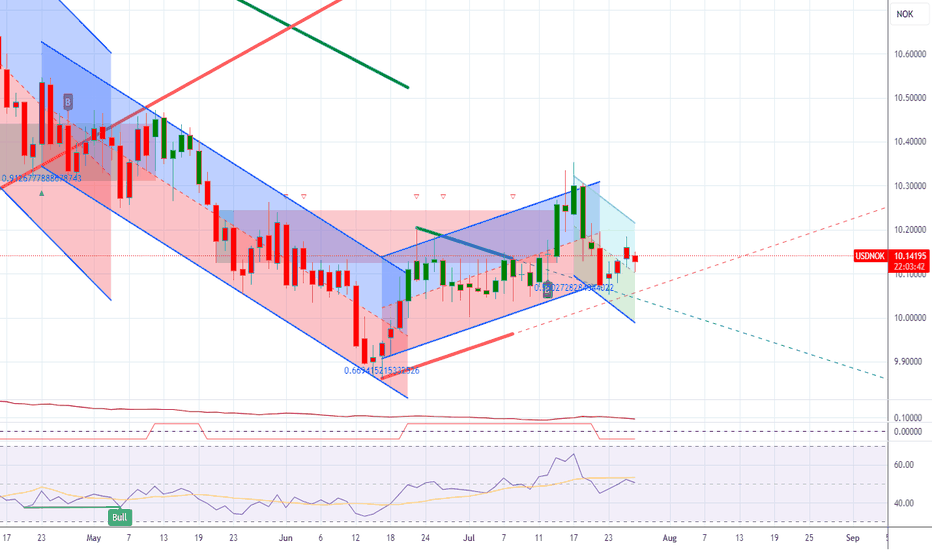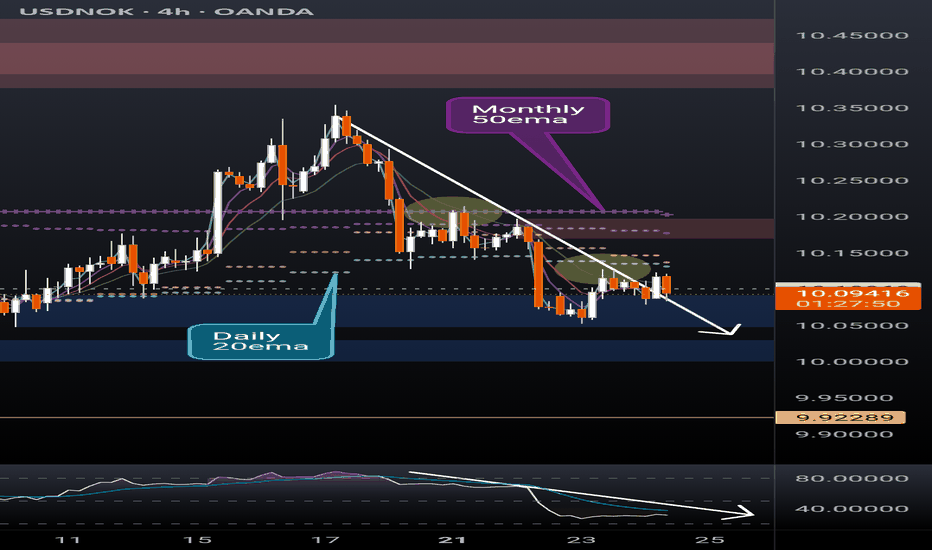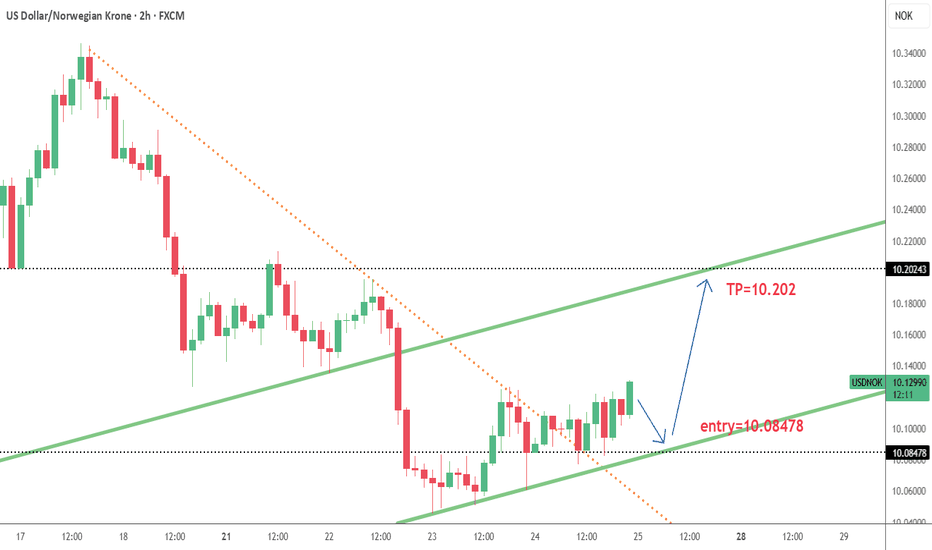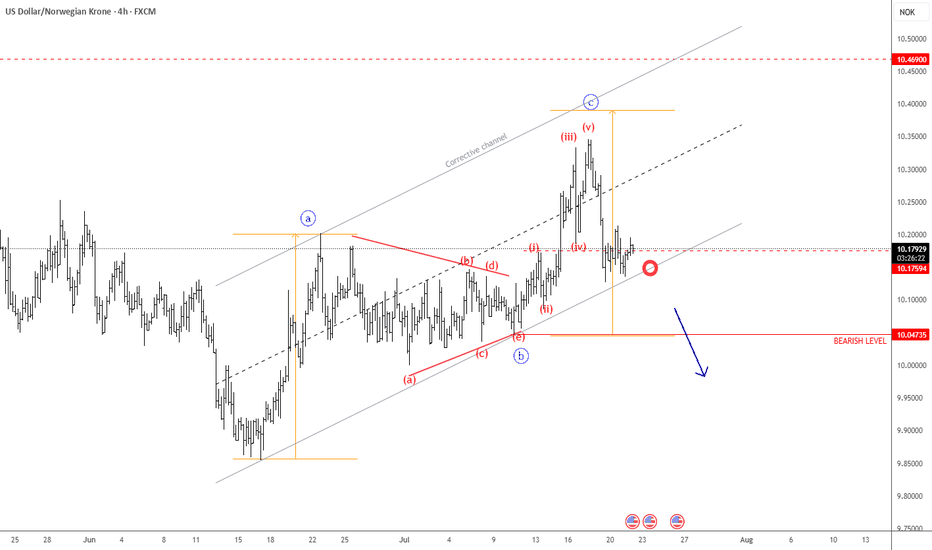USDNOK trade ideas
USDNOK short potential setupUSDNOK recently broke down below the monthly 50ema (overlayed on this 4h chart) and has rejected off the daily 20ema (overlayed) twice this week. RSI is showing bearish momentum after a brief overbought period while the PA has remained in a strong downtrend. Short setup potential is evident but not certain.
I'm a cat not a financial advisor.
USDNOK Remains BearishUSDNOK made a three-wave rise from the recent low, indicating an abc correction within a downtrend—especially considering the triangle in wave "b" in the middle, and the current sharp decline following a completed five-wave impulse in wave "c". As long as this structure remains intact, there is still a risk of another leg lower. Therefore, we can expect further weakness toward the June lows, especially if it breaks below the channel support line. Just watch out for short-term intraday pullbacks.
USDNOK Bearish Continuation Setup USDNOK Bearish Continuation Setup
🗓 Published: June 26, 2025
🕒 Timeframes: 1D & 4H
📍 Instrument: USD/NOK
📊 Technical Bias: Bearish
🧠 Analysis Summary
USDNOK has failed to reclaim the previous support-turned-resistance zone around 10.12–10.23 (highlighted in red). This rejection confirms a continuation of the broader downtrend that started in Q2 2025.
The current retracement into resistance provides a high-probability area for a trend continuation trade, targeting multiple support levels below. This setup aligns on both the 4H and Daily charts, increasing confidence in bearish continuation.
📍 Key Levels
Level Description
10.2336 Daily supply high / key resistance
10.1215–10.1191 Breaker block (supply zone)
10.0103 Minor support flip level
9.8500 Short-term target (horizontal level)
9.7565 Previous demand level
9.7469 Final target (major support)
🔁 Trade Setup
Entry Zone:
🔴 Enter between 10.12 – 10.23 (supply rejection)
🔄 OR enter on confirmation below 10.01
Take Profit Targets:
✅ TP1: 9.8500
✅ TP2: 9.7565
✅ TP3: 9.7469
Stop Loss:
❌ SL above 10.24 (above supply zone)
📦 Confluence Factors
Major breakdown from multi-year support zone (April–June 2025)
Retest of bearish order block (supply)
Large bearish volume in recent weeks
Continuation pattern with lower highs and lower lows
⚠️ Risk Note
If price reclaims and closes above 10.24 on the daily timeframe, this bearish setup is invalidated. Use position sizing accordingly and trail stops as new swing lows form.
💬 What do you think about USDNOK’s breakdown? Drop a comment and share your thoughts.
📉 Stay safe and trade smart.
Let me know if you'd like this formatted for direct pasting into a TradingView "Publish Idea" form or posted alongside another pair for a multi-chart setup.
Rendon1
USDNOKOn the monthly charts we have a confirmed bearish trend with a bullish correction in play.
On the weekly charts we have a shift in order flow confirming our bearish bias though its a long term view. We have an impulsive bearish move that has necessitated a bullish correction to clear previous disequilibrium.
The break in daily structure confirms shift in order flow from bullish to bearish. Presently we are bearish, in consonance with our monthly and weekly view.
USDNOK - US Dollar / Norwegian Krone (Daily chart, OANDA)USDNOK - United States Dollar / Norwegian Krone (Daily chart, OANDA) - Short Position; Short-term research idea.
Risk assessment: Medium {support structure integrity risk}
Risk/Reward ratio ~ 2
Current Market Price (CMP) ~ 10.31500
Entry limit ~ 10.30000 on May 06, 2025
Target limit ~ 10.50000 (+1.94%)
Stop order limit ~ 10.18000 (-1.17%)
Disclaimer: Investments in securities markets are subject to market risks. All information presented in this group is strictly for reference and personal study purposes only and is not a recommendation and/or a solicitation to act upon under any interpretation of the letter.
LEGEND:
{curly brackets} = observations
= important updates
(parentheses) = information
~ tilde/approximation = variable value
-hyphen = fixed value
USDNOK - Buy opportunity towards 10,8300?OANDA:USDNOK is testing a clear support area, marked by previous bullish reversals and strong buyer interest. The recent bearish move into this zone suggests a potential buying opportunity if buyers confirm control.
If bullish signals, such as strong rejection wicks or bullish candlestick patterns, emerge, I anticipate an upward move toward 10,8300. If the support fails to hold however, further downside could be expected.
Remember, always confirm your setups and trade with solid risk management.
USD/NOK Long Trade Idea –Potential Reversal from Channel SupportOverview
This analysis presents a long trade setup for the USD/NOK currency pair based on the price action within an ascending parallel channel on the daily timeframe. The market is currently testing the lower boundary of the channel, suggesting a potential buying opportunity for a reversal towards higher levels.
Technical Analysis
1. Price Channel & Key Levels
The USD/NOK pair has been trending upwards within a rising channel, forming consistent higher highs and higher lows.
Current price: 10.6387, nearing the lower trendline support of the channel.
The upper resistance of the channel aligns near 11.17, making it a potential price target.
A stop-loss level is placed below the channel at 10.43, limiting downside risk.
2. Indicators Confirm Oversold Conditions
Stochastic Momentum Index (SMI): The SMI shows a sharp decline, entering an oversold region, indicating potential bullish momentum soon.
Relative Strength Index (RSI): The RSI is at 21.93, an extremely oversold level, suggesting a possible reversal in the coming sessions.
Trade Plan
Entry: Around 10.63, near the lower boundary of the channel.
Target (Take Profit - TP): 11.17, aligned with the upper trendline.
Stop-Loss (SL): 10.43, below recent lows.
Risk-Reward Ratio: Approximately 2:1, making this a favorable setup.
Conclusion
USD/NOK is currently at a key support level within a well-defined ascending trend channel. Oversold indicators and strong historical price action at this level suggest a bullish reversal is likely. This long position setup provides an excellent opportunity for traders looking to capture the next move towards 11.17, with a defined risk at 10.43.
Market Outlook: Bullish Flag and Bearish Shark Patterns in FocusPEPPERSTONE:USDNOK
Key Technical Levels for USDNOK
Weekly Fractal Resistance: 11.47
Daily Fractal Support: 11.21
Monthly Fractal Support: 10.38 (formed in late September)
Breakout Resistance (December 2024): 11.13
These levels have been pivotal in guiding the pair’s movements, and it’s essential to keep an eye on them for future developments.
Bullish Flag Pattern in Play
One of the more notable formations in the current chart is the bullish flag pattern. This pattern suggests that the pair could see further upward movement, in line with the broader positive trend that has been in place since the formation of the monthly fractal support at 10.38 back in September.
The bullish flag pattern typically indicates that the market is taking a breather before continuing in the direction of the prior trend. In this case, the recent pullback to 11.21 (daily fractal support) could be setting the stage for a further rise toward the 11.47 resistance level, or even beyond it, if momentum continues to build.
Bearish Shark Pattern Projection
While the bullish outlook is present, traders should also be cautious of the emerging bearish shark pattern. This pattern, which began taking shape after the breakout above the monthly fractal resistance at 11.13 in December, projects a potential reversal at the 11.56 level, which coincides with the 224% Fibonacci extension.
Bearish Shark Pattern Implications
If the price reaches 11.56, this could signal a reversal and the start of a downward move.
A pullback could occur, testing the monthly fractal resistance at 11.13 or possibly even moving lower to 10.97, which is considered the default target for the bearish shark pattern.
Given the current position of the pair and the technical levels in play, it's important to be prepared for both bullish and bearish scenarios in the near term.
Happy Trading,
André






















